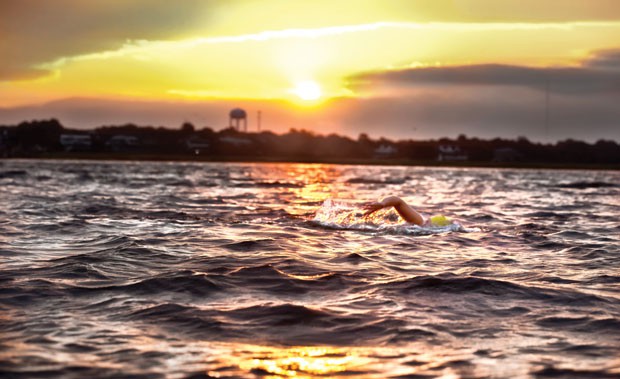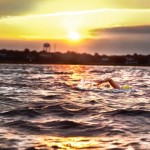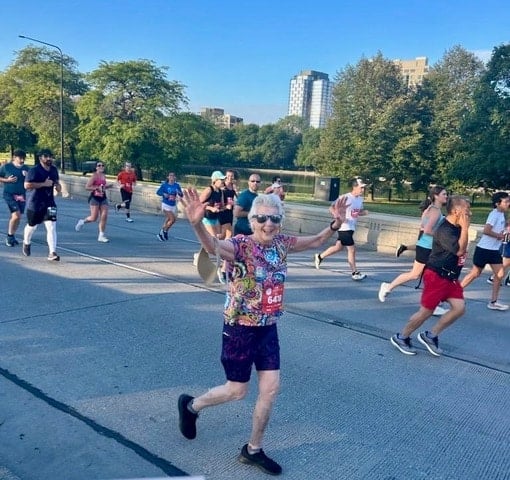Kathleen Wilson swims around Charleston, S.C. Photo: Gary McElveen![]()
Karah Nazor Friberg hates the TV show River Monsters, which centers around man-eating fish. A show that highlights the vicious underbelly of our waterways hits close to home for Friberg, an accomplished marathon-distance swimmer living in Chattanooga. She spends most of her free time swimming long distances in rivers. The 34-year-old has ticked off some impressive marathon-distance swims, including swimming the English Channel, and she says it’s best not to think about what’s lurking beneath the surface.
“In the Tennessee River, it’s catfish. Really big catfish,” Friberg says. “People catch huge ones all the time. They’re the size of Volkswagens. Okay, half the size of Volkswagens. But they’re still scary.”
According to Friberg, you can’t think about the catfish, or the sharks, or the cold temperatures or the incredible distances, or any of the concerns that keep most of us out of the water. To swim open water, you have to enter with a clear mind, free of negative thoughts. It’s a process that more and more athletes are discovering as the sport of open water swimming spreads. Every year, more swimmers are crossing bays and lakes and knocking out long stretches of mountain rivers.
“I have this urge when I’m at the edge of water to get in and swim straight out,” Friberg says. “I want to swim all the way to the other end. No walls. No boundaries. It’s like backpacking in a wilderness.”
She is currently training for a 30-mile relay swim that begins at the Farallon Islands and ends in San Francisco, passing under the Golden Gate Bridge and through “sharky” waters. After that, she’s off to swim 8.5 miles from Maui to Molokai Island, also through sharky waters. Friberg doesn’t like the notion of swimming with sharks, but the fear isn’t strong enough to keep her onshore.
“When you’re swimming open water, you’re a part of the elements, probably more so than in any other situation,” she says. “That’s part of the appeal. You’re literally immersed in nature.”
That same sense of immersion that attracts Friberg keeps the majority of us out of open water. Americans aren’t in love with swimming. We’re not like Western Europeans, where open water swimming clubs are almost as common as running clubs. According to a Gallup poll commissioned in the late 1990s, 46 percent of American adults are afraid of the deep end of pools, and 64 percent of us are afraid of deep open water, be it an ocean, lake, or river.
Richmond-based triathlete Jay Peluso has created an entire coaching business designed to eradicate that fear of open water. “A lot of people aren’t comfortable with being out in a river or a lake. It’s the fear of the unknown,” says Peluso. “Some people freak out when their feet touch the bottom of a river. Or they’re scared of the wildlife. Even some competent pool swimmers are uncomfortable with open water. They’ll start to hyperventilate and panic in the river. What happens is they lose perspective. The water’s murky, there are no black lines or tiles to mark distance. It can be overwhelming.”
Even veteran swimmers can be overwhelmed by the enormity of a lengthy open water swim, particularly when swimming in the ocean. Denis Crean is a long-time swimmer who has competed in some of the country’s most lauded and longest open water races. He was training for a pier to pier race in California one day when panic began to take hold.
“Those piers stick a half a mile out into the ocean. I was swimming by myself between piers, training for a race. You’ve got nothing to hold onto out there. You’re all alone. All of a sudden, your mind starts playing tricks on you. I was out there and I realized, if I went under, or if something ate me, no one would know. The lifeguards wouldn’t see me. I stopped, looked around, but what do you do? I had to keep swimming to the next pier.”
While swim technique and fitness are the foundations of open water success, coping with the mental aspect of swimming great distances is just as important.
“Negative thoughts will drag you down,” Crean says. “When you’re swimming 20 miles across a bay, your body is screaming at you to stop and you begin to doubt yourself pretty quickly. You can’t think about the waves, the current, the sharks. You can’t think about how tired you are. If you do, it’s over. Those negative thoughts will act like weights and you’ll sink.”
With his budding triathlete clients, Jay Peluso begins developing a solid foundation of swimming technique in the pool, then introduces open water in a comfortable group setting with safety kayakers along for the ride. He’s also developed a local open water race series to give athletes as many chances as possible to dive into the world of open water.
“Acclimation is the key to enjoying open water swims,” Peluso says. “The more you do it, the less anxious you’ll be.”










